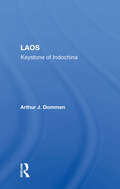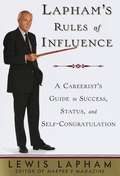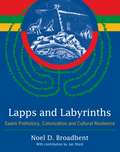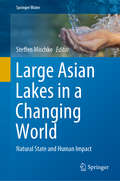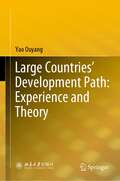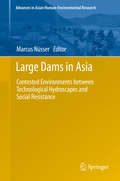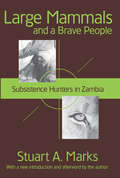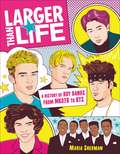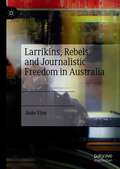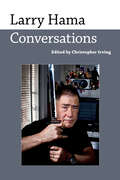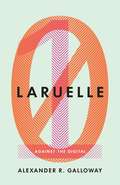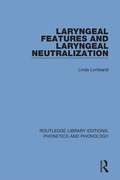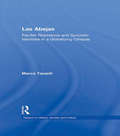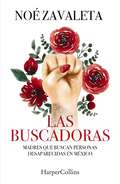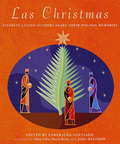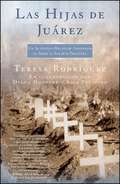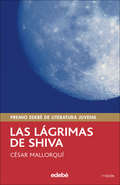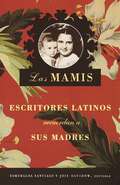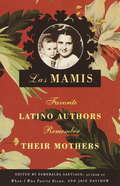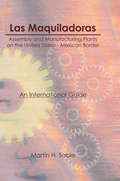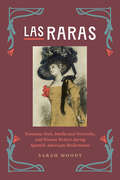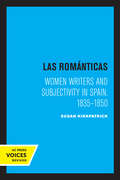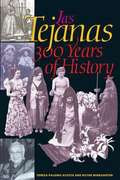- Table View
- List View
Laos: Keystone Of Indochina
by Arthur J DommenTheravada Buddhists in the lowlands and animists in the mountains, the people of Laos have wanted nothing more than to live at peace. Unfortunately, their country's location between two more powerful neighbors, Vietnam and Thailand, has made it the victim of invasion and domination since the fifteenth century. In this analytic introduction to Laos,
Lapham's Rules of Influence: A Careerist’s Guide to Success, Status and Self-Congratulation
by Lewis LaphamAs the editor of Harper's Magazine, Lewis Lapham has enjoyed entrée to America's "cultural elite", a class distinguished by its talent for currying favor, licking boots, and kissing ass. Drawing upon a lifetime of experience among the cognoscenti, Mr. Lapham breaks rank and reveals the unspoken secrets of getting ahead: what to say, how to dress, when to lie, whom to befriend, where to be seen, and why it is absolutely essential to wear clean shoes. "The first impression is also the last impression. You don't wish to be remembered as the stain on the rug." Anyone interested in self-advancement will be transformed by Lapham's "Rules of Influence", which offers proven nuggets of wisdom. For example, when trying to impress the boss, remember: "Flattery cannot be too often or too recklessly applied. Think of it as suntan lotion or moisturizing cream." Written with stinging wit and tongue planted firmly in cheek, Lapham's "Rules of Influence" is a brilliant critique of class and manners in America, packed with the kind of irreverent observation that only Lewis Lapham can provide. Seek out the acquaintance of people richer and more important than yourself, and never take an interest in people who cannot do you any favors.
Lapps and Labyrinths: Saami Prehistory, Colonization, and Cultural Resilience
by Noel D. Broadbent Jan StoraProfessor Noel D. Broadbent is one of Sweden's foremost experts on north Swedish archaeology and literally wrote the book on the prehistory of the Skellefteå region on the North Bothnian coast. This knowledge is now brought to bear on the issue of Saami origins. The focus is on the successful adaptive strategies of Saami societies over thousands of years - a testimony to Saami resiliency, of relevance to the survival of indigenous societies worldwide today.
Large Asian Lakes in a Changing World: Natural State and Human Impact (Springer Water)
by Steffen MischkeDescribing the natural state of eight important lakes in Asia and the human impact on these lake ecosystems, this book offers a valuable reference guide. Over the past several decades the Aral Sea, Dead Sea, Lake Balkhash and other major lakes in Asia have undergone significant changes with regard to their size, water level, chemical composition, and flora and fauna. Most of these changes resulted from the loss of water from tributaries (now used for irrigation farming) or increasing consumption in local industries and households. However, significant human impacts may have begun as early as 2000 years ago. In addition to the three lakes mentioned above, Lake Sevan (Armenia), the Caspian Sea (Azerbaijan, Iran, Kazakhstan, Russia, Turkmenistan), Lake Issyk-Kul (Kyrgyzstan), and Lake Lop Nur (China) are discussed as the most prominent examples of changing lake ecosystems. In contrast, an example of an almost pristine lake ecosystem is included with the report on Lake Uvs Nuur (Mongolia). For each lake, the book summarizes its origin and early geological history, and reconstructs its natural state and variability on the basis of proxy records from drilled or exposed lake sediments that have accumulated since the last ice age. The frequently observed reductions in lake level and size during most recent decades led often to significant environmental impacts in the respective lake catchments including vegetation deterioration, soil erosion and badland formation, soil salinization or the formation of sinkholes.
Large Countries’ Development Path: Experience and Theory
by Yao OuyangThis book aims to propose a unique analytical framework to find out the general successful experience for large developing countries, which are defined with two main physical characters of large population and vast land. They are naturally crucial for the global development. Thirteen countries are chosen as large developing countries in this book, which are China, India, Russia, Brazil, Mexico, Indonesia, South Africa, Iran, Egypt, Pakistan, Nigeria, Ethiopia and Congo (DRC). On the basis of selecting massive data, the author analyzes the performance of large countries in terms of human resources, natural resources, market size and other factors. The book conducts the comparative study of large countries’ latecomer strength, transformation path and innovation strategy with the perspective of development economics. It presents a comprehensive overview about large developing countries
Large Dams in Asia
by Marcus NüsserThis book explores the multi-dimensional asymmetries of scale, time, and directions in the large dam controversy with a regional focus on Asia, especially on India and China. Whereas the concept of large-scale transformation of fluvial environments into technological hydroscapes originated in the West, widespread construction of large dams started in the countries of the Global South in the period after decolonisation. Construction and operation of large dams are amongst the most prestigious but also most sensitive development issues, often accompanied by massive resistance of adversely affected people and civil society organisations. Based on the notion of a contested politicised environment, various case studies are analysed to identify the dominant narratives and imaginations that shape the large dams debate. This volume largely contains contributions related to several subprojects from within the Cluster of Excellence 'Asia and Europe in a Global Context: Shifting Asymmetries in Cultural Flows', based at Heidelberg University, with several expert contributions from external researchers.
Large Mammals and a Brave People: Subsistence Hunters in Zambia
by Stuart A. MarksThe Valley Bisa people inhabit the Luangwa Valley in central Zambia. Among them, the hunter, who tracks such large game as the lion, elephant, and buffalo, commands great respect and esteem from the other members of the lineage who traditionally rely on him for their subsistence and protection. Although the social organization and technology of the Bisa people have undergone tremendous change in the last one hundred years, the role of hunter retains its social importance, and the legitimizing hunting rituals have their roots in local history. Drawing on data collected during his fieldwork among the Bisa continuing since the 1960s, Stuart Marks describes the changes that have occurred in hunting patterns, the sociological variables that govern an individual's decision to become a hunter, and the common cosmological convictions that hunters bring to their profession. Available for the first time in paperback, the new introduction and afterword to this edition reflect on methodological and ideological changes in the anthropological study of African peoples as well as updating the circumstances of the Bisa people since the book's first appearance in 1976. Through the interventions of the larger national society the Bisa have lost much of their land and access to important portions of their resources while experiencing repression in their struggles to maintain livelihoods with what local assets are left. Nevertheless, Marks notes that they face their hardships with tolerance, integrity, persistence, and humility. The general reader, as well as prehistorians and anthropologists concerned with human evolution and hunting societies, will find this volume useful. It will also be of interest to wildlife managers and ecologists.
Larger Than Life: A History of Boy Bands from NKOTB to BTS
by Maria Shermanp.p1 {margin: 0.0px 0.0px 0.0px 0.0px; font: 14.0px Calibri} p.p2 {margin: 0.0px 0.0px 0.0px 0.0px; font: 14.0px Calibri; min-height: 17.0px} This nostalgic, fully-illustrated history of boy bands -- written by culture critic and boy band stan Maria Sherman -- is a must-have for diehard fans of the genre and beyond.The music, the fans, the choreography, the clothes, the merch, the hair. Long after Beatlemania came and went, a new unstoppable boy band era emerged. Fueled by good looks and even greater hooks, the pop phenomenon that dominated the '80s, '90s, and 2000s has left a long-lasting mark on culture, and it's time we celebrate it. Written by super fan Maria Sherman for stans and curious parties alike, Larger Than Life is the definitive guide to boy bands, delivered with a mix of serious obsession and tongue-in-cheek humor.Larger Than Life begins with a brief history of male vocal groups, spotlighting The Beatles, the Jackson 5, and Menudo before diving into the building blocks of these beloved acts in "Boy Bands 101." She also focuses on artists like New Edition, New Kids on the Block, Backstreet Boys, *NSYNC, One Direction, and BTS before ending with an interrogation into the future of boy bands. Included throughout are Tiger Beat-inspired illustrations, capsule histories of the swoon-iest groups, in-depth investigations into one-hit wonders, and sidebars dedicated to conspiracy theories, dating, in-fighting, haters, fan fiction, fashion (Justin and Britney in denim, of course), and so much more.Informative, affectionate, funny, and never, ever fan-shaming, Larger Than Life is the first and only text of its kind: the ultimate celebration of boy bands and proof that this once maligned music can never go unappreciated.
Larrikins, Rebels and Journalistic Freedom in Australia
by Josie VineLarrikins, Rebels, and Journalistic Freedom is a cultural history of Australian journalism. In a democratic nation where a free news media is not guaranteed, Australian journalism has inherited what could be described as a ‘Larrikin’ tradition to protect its independence. This book mines Australian journalism’s rebelliousness, humor and distinct disrespect for authority in various socio-historical contexts, to explore its determination to maintain professional independence. Beginning with a Larrikin analysis of Australian journalism’s inherited Enlightenment tradition, Dr Josie Vine takes the reader through the Colonial era’s hardships, Federation, two World Wars, the Cold War’s fear and suspicion, the swinging sixties, a Prime Minister’s dismissal, 1980’s neo-liberalism, post-9/11 and, finally, provides a conclusive synthesis of current Australian journalism culture. Throughout, the book highlights the audacious, iconoclastic and determined figure of the Larrikin-journalist, forever pushing boundaries to protect democracy’s cornerstone – freedom of the news media. “Book-length histories of Australian journalism are still relatively rare, but what makes this new arrival particularly welcome is the way in which it is structured around an exploration of the ‘Larrikin paradox’. This refers to the fact that although Australian journalism may profess to be ‘professional’ and ‘reputable’, it can also be raucous, unruly and disrespectful in pursuit of what it sees as its democratic purposes. The Larrikin may be a uniquely Australian figure but the paradox is far from confined to Australian journalism (not least because of the influence of erstwhile Australian Rupert Murdoch on journalism in the Anglosphere), and this book should be of considerable interest to those concerned with the means whereby journalism performs its democratic, Fourth Estate role in modern democracies. This is an extremely very well-informed and highly insightful work which ought to appeal equally to those interested in journalism and in Australian politics.” — Julian Petley, Professor, Brunel University London, UK
Larry Hama: Conversations (Conversations with Comic Artists Series)
by Christopher IrvingLarry Hama (b. 1949) is the writer and cartoonist who helped develop the 1980s G.I. Joe toy line and created a new generation of fans from the tie-in comic book. Through many interviews, this volume reveals that G.I. Joe is far from his greatest feat as an artist. At different points in his life and career, Hama was mentored by comics legends Bernard Krigstein, Wallace Wood, and Neal Adams. Though their impact left an impression on his work, Hama has created a unique brand of storytelling that crosses various media. For example, he devised the character Bucky O'Hare, a green rabbit in outer space that was made into a comic book, toy line, video game, and television cartoon—with each medium in mind. Hama also discusses his varied career, from working at Neal Adams and Dick Giordano’s legendary Continuity to editing a humor magazine at Marvel, developing G.I. Joe, and enjoying a long run as writer of Wolverine. This volume also explores Hama's life outside of comics. He is an activist in the Asian American community, a musician, and an actor in film and stage. He has also appeared in minor roles on the television shows M*A*S*H and Saturday Night Live and on Broadway. Editor and historian Christopher Irving compiles six of his own interviews with Hama, some of which are unpublished, and compiled others that range through Hama’s illustrious career. The first academic volume on the artist, this collection gives a snapshot of Hama’s unique character-driven and visual approach to comics’ storytelling.
Laruelle: Against the Digital (Posthumanities #31)
by Alexander R. GallowayLaruelle is one of the first books in English to undertake in an extended critical survey of the work of the idiosyncratic French thinker François Laruelle, the promulgator of non-standard philosophy. Laruelle, who was born in 1937, has recently gained widespread recognition, and Alexander R. Galloway suggests that readers may benefit from colliding Laruelle&’s concept of the One with its binary counterpart, the Zero, to explore more fully the relationship between philosophy and the digital. In Laruelle, Galloway argues that the digital is a philosophical concept and not simply a technical one, employing a detailed analysis of Laruelle to build this case while referencing other thinkers in the French and Continental traditions, including Alain Badiou, Gilles Deleuze, Martin Heidegger, and Immanuel Kant. In order to explain clearly Laruelle&’s concepts such as the philosophical decision and the principle of sufficient philosophy, Galloway lays a broad foundation with his discussions of &“the One&” as it has developed in continental philosophy, the standard model of philosophy, and how philosophers view &“the digital.&”Digital machines dominate today&’s world, while so-called digital thinking—that is, binary thinking such as presence and absence or self and world—is often synonymous with what it means to think at all. In examining Laruelle and digitality together, Galloway shows how Laruelle remains a profoundly non-digital thinker—perhaps the only non-digital thinker today—and engages in an extensive discussion on the interconnections between media, philosophy, and technology.
Laryngeal Features and Laryngeal Neutralization (Routledge Library Editions: Phonetics and Phonology #15)
by Linda LombardiFirst published in 1994. In this study, the author proposes that neutralization is the result of a wellformedness condition that the author calls the Laryngeal Constraint: In languages that have laryngeal neutralization, a laryngeal node is only licensed in a particular syllabic configuration; elsewhere the node will delink to repair the violation of well-formedness. This approach to neutralization is required to correctly explain the typology of laryngeal neutralization. This title will be of interest to students of language and linguistics.
Las Abejas: Pacifist Resistance and Syncretic Identities in a Globalizing Chiapas (Religion in History, Society and Culture #Vol. 1)
by Marco TavantiLas Abejas came to be known by the international community as the civil counterpart to the neozapatista movements and as a Christian pacifist movement. This book presents the voices of Las Abejas and of numerous collaborators alongside an innovative theoretical analysis of the dynamics of identity construction. The uniqueness of this study is the analysis of the role of international human rights observers in relation to indigenous communities in resistance. In this fascinating study, Marco Tavanti explains how cultural, religious, political, human rights and nonviolent frameworks combine in a syncretic identity of resistance.
Las Buscadoras: Madres que buscan personas desaparecidas en México
by Noé ZavaletaEllas buscan a sus hijas, sus hijos, maridos y familiares. Es una historia cotidiana en nuestro país. Les empezaron a decir &“tesoros&”, a los restos óseos hallados en las múltiples fosas clandestinas de nuestro país. Principalmente en las entidades de Veracruz, Sinaloa, Guerrero, Jalisco, Michoacán y recientemente en Guanajuato. Este libro recopila, el viacrucis endemoniado de la búsqueda en vida y en muerte de los desaparecidos en México. Más de 70 mil ausencias y contando, acumulando, por cientos, por miles.Sus familiares se agruparon en &“Colectivos&”. No los une una filiación política, ni un gustos personales, tampoco una creencia religiosa, ni un estatus social, sino la &“ausencia&” de un ser querido. Un familiar &“tragado por la tierra&” en los cientos de agujeros negros que existen en México.The SeekersThey look for their daughters, their sons, husbands and relatives. It is an everyday story in our country. They will say "treasures" to the skeletal remains found in the many clandestine graves in our country. Mainly in the entities of Veracruz, Sinaloa, Guerrero, Jalisco, Michoacán and recently in Guanajuato. This book compiles the demonic via crucis of the search in life and in death for the disappeared in Mexico. More than 70 thousand absences and counting, accumulating, by hundreds, by miles.His relatives were grouped into "Collectives". They are not united by a political affiliation, or a personal taste, or a religious belief, or a social status, but the "absence" of a loved one. A relative "swallowed by the earth" in the hundreds of black holes that exist in Mexico.
Las Christmas: Favorite Latino Authors Share Their Holiday Memories
by Esmeralda Santiago Joie Davidow24 stories, 6 poems and songs, and 22 recipes for the Christmas season.
Las Estaciones Del Ferrocarril Subterráneo (La Historia Oculta (hidden History) Ser.)
by Caroline KennonThe Underground Railroad was the massive effort by slaves and free people to secretly bring thousands of blacks to freedom in the North during the 19th century. This thought-provoking book will capture readers' imaginations and fill them with awe for the brave "conductors" and "passengers" on the Railroad. They'll learn about the many safe havens, called "depots," that housed fugitives and the secret passages within them that hid slaves from their pursuers. Information about the American Civil War and the Fugitive Slave Act, biographies of figures vital to the Underground Railroad, and stunning photographs and artwork are included in this important work about a terrible time in American history.
Las Hijas de Juarez (Daughters of Juarez)
by Lisa Pulitzer Teresa Rodriguez Diana MontanCiudad Juárez, México, queda en la frontera sur del Río Bravo, frente a El Paso, Texas. Por más de doce años, aquí se ha llevado a cabo un sinnúmero de crímenes atroces contra mujeres y niñas que incluyen secuestros, violaciones, mutilaciones y asesinatos. Según Amnistía Internacional, para 2006, se habían encontrado más de 400 cadáveres, sin contar centenares de desaparecidas. Muchos creen que las muertes se deben a la violencia e impunidad que imperan en la ciudad. Entre las teorías que se proponen están uno o varios asesinos en serie, los sacrificios en rituales satánicos, el poderoso cartel del narcotráfico de Juárez y hasta corruptos funcionarios mexicanos que encubren a los responsables. Las hijas de Juárez promete ser una reveladora obra literaria que revela no sólo la brutalidad tras estos sangrientos hechos, sino las violaciones de los derechos humanos de la mujer en México.
Las Lágrimas de Shiva (Periscopio)
by César Mallorquí del Corral Paco Giménez Ortega SantosEn cierta ocasión, hace ya mucho tiempo, vi un fantasma. Sí, un espectro, una aparición, un espíritu; lo puedes llamar como quieras, el caso es que lo vi. Ocurrió el mismo año en que el hombre llegó a la Luna y, aunque hubo momentos en los que pasé mucho miedo, esta historia no es lo que suele llamarse una novela de terror. --Todo comenzó con un enigma: el misterio de un objeto muy valioso que estuvo perdido durante siete décadas. Las Lágrimas de Shiva, así se llamaba ese objeto extraviado. A su alrededor tuvieron lugar venganzas cruzadas, y amores prohibidos, y extrañas desapariciones.--Hubo un fantasma, sí, y un viejo secreto oculto en las sombras, pero también hubo mucho más.
Las Mamis
by Esmeralda Santiago Joie Davidow Nina Torres-VidalUna maravillosa antología nueva--las escritoras y los escritores latinos más admirados comparten recuerdos de sus madres. Las mujeres amorosamente retratadas en lasLas Mamisrepresentan la diversidad de la vida y cultura latinas. Provienen de las familias ricas de las grandes ciudades de Latinoamérica, de familias campesinas emigrantes y también de la variedad de mundos intermedios. Además, comparten todas una extraordinaria fuerza interior, frecuentemente retada por la adversidad. Presionadas por circunstancias y expectativas culturales conflictivas, lograron enfrentar los retos de la maternidad y dejar para sus hijos e hijas un legado perdurable. Y ahora, en estos vívidos, conmovedores y, en ocasiones, divertidísimos recuerdos, todos imbuidos de un claro sabor latino,Las Mamiscelebra la universalidad del amor de familia y el vínculo especial entre madres e hijos. Colaboradores: Marjorie Agosín Alba Ambert Liz Balmaseda Mandalit del Barco Gioconda Belli Junot Díaz María Amparo Escandón Dagoberto Gilb Francisco Goldman Jaime Manrique Gustavo Pérez-Firmat Esmeralda Santiago Ilán Stavans Piri Thomas
Las Mamis
by Esmeralda Santiago Joie DavidowA marvelous new anthology from the editors of Las Christmas in which our most admired Latino authors share memories of their mothers. The women lovingly portrayed in Las Mamis represent a cross section of Latino life and culture. They come from rich families in the big cities of Latin America, from rural immigrant families, and from the worlds in between-and they share an extraordinary inner strength, often maintained against incredible odds. Pressed by conflicting cultural expectations, circumstance, and religion, they have managed the challenges of motherhood, leaving enduring legacies for their children. Now, in these vivid, poignant, and sometimes hilarious reminiscences--all of them infused with distinct sabor latino--Las Mamis celebrates the universality of family love and the special bond between mothers and children.Contributors include: Esmeralda Santiago, Piri Thomas, Marjorie Agosin, Junot Diaz, Alba Ambert, Liz Balmaseda, Mandalit del Barco, Gioconda Belli, Maria Escandon, Dagoberto Gilb, Francisco Goldman, Jaime Manrique, Gustavo Perez-Firmat, Ilan Stavans.
Las Mamis
by Esmeralda SantiagoUna maravillosa antología nueva--las escritoras y los escritores latinos más admirados comparten recuerdos de sus madres. Las mujeres amorosamente retratadas en las Las Mamis representan la diversidad de la vida y cultura latinas. Provienen de las familias ricas de las grandes ciudades de Latinoamérica, de familias campesinas emigrantes y también de la variedad de mundos intermedios. Además, comparten todas una extraordinaria fuerza interior, frecuentemente retada por la adversidad. Presionadas por circunstancias y expectativas culturales conflictivas, lograron enfrentar los retos de la maternidad y dejar para sus hijos e hijas un legado perdurable. Y ahora, en estos vívidos, conmovedores y, en ocasiones, divertidísimos recuerdos, todos imbuidos de un claro sabor latino, Las Mamis celebra la universalidad del amor de familia y el vínculo especial entre madres e hijos. Colaboradores: Marjorie Agosín Alba Ambert Liz Balmaseda Mandalit del Barco Gioconda Belli Junot Díaz María Amparo Escandón Dagoberto Gilb Francisco Goldman Jaime Manrique Gustavo Pérez-Firmat Esmeralda Santiago Ilán Stavans Piri Thomas
Las Maquiladoras: An International Guide
by Martin SableHere is a one-stop research resource on the assembly and manufacturing plants on the U.S.-Mexico border, termed Maquiladoras. A combination bibliography and directory, Las Maquiladoras focuses on various aspects of the American-owned companies that are located in Mexico and employ Mexican citizens.While the thrust of the items included in the select bibliography is on the industrial, commercial, and financial aspects of the phenomenon, including the actions of multinational corporations and their investments, there are also entries dealing with the matter of labor, United States and Mexican governmental undertakings, legal and urban problems, regional development and planning, population, technology transfer, sociocultural considerations, and the interdisciplinary field of border studies, which is concerned with a host of topics ranging form health and education to urban geography, economic matters, and the cultural impact on border residents of the establishment of maquiladoras. The impact of economic development, industrialization, and urbanization on border culture is also reflected.In the directory, readers can locate names and addresses of local, state, and federal level government agencies in the U.S. and Mexico; information centers; labor unions; professional associations; and research centers.The bibliography, comprised of books and book chapters, pamphlets, conference papers and proceedings, government publications, scholarly dissertations, videotapes of television programs, and magazine, journal, and newspaper articles, will be an indispensable tool for business people, bankers, journalists, government experts, economists, students, and librarians. The current interest in border studies and in Mexico, in particular, will make this unique book especially useful to scholars of folklore, geography, history, labor, political science, and sociology.Special features in the book include a list of experts in a variety of disciplines and a listing of U.S. and Mexican cities and towns on opposite sides of the border. Because the number of maquiladoras is expected to continue expanding rapidly, this volume should remain a highly valuable resource.
Las Raras: Feminine Style, Intellectual Networks, and Women Writers during Spanish-American Modernismo
by Sarah MoodyLas Raras proposes that the Modernistas&’ advocacy for a writing style they considered feminine helps us to understand why so few (and perhaps no) women were accepted as active participants in Modernismo. Author Sarah Moody studies how particular writers contributed to the idea of a feminine aesthetic and tracks the intellectual networks of Modernismo through periodicals and personal papers, such as albums and correspondence. Buenos Aires, Paris, and Montevideo figure prominently in this transatlantic study, which reexamines some of the most important period writers in Spanish, including Rubén Darío, Amado Nervo, and Enrique Gómez Carrillo. This book also considers the critiques launched by women writers, such as Aurora Cáceres, Clorinda Matto de Turner, and María Eugenia Vaz Ferreira, who experienced Modernista exclusion firsthand, deconstructed the Modernista discourse of a modern, &“feminine&” style, and built literary success in alternative terms. These writers reoriented the discussion about women in modernity to address women&’s education, professionalization, and advocacy for social and civic improvements. In this study, Modernismo emerges as both a literary style and an intellectual network, in which style and sociability are mutually determining and combine to form a system of prestige and validation that excluded women writers.
Las Romanticas: Women Writers and Subjectivity in Spain, 1835-1850
by Susan KirkpatrickA pioneering critical work that establishes the existence and elaborates the history of a female literary tradition in Spain early in the nineteenth century, this book will greatly interest specialists in Spanish literature. It also addresses those concerned with Romanticism in general, with feminist criticism, and with the cultural history of women. Who were las románticas? The first generation of Spanish women to conceive of themselves as "writing women," they made their appearance in the press around 1841. It was the apogee of Spain's Romantic movement and of a first wave of liberal reforms, and these women gave voice to their experience as women within the terms of liberal Romantic ideology. Susan Kirkpatrick examines the textual representations that link liberal ideology, Romantic configurations of subjectivity, and women's writing, in an exciting revelation of early nineteenth-century gender consciousness. This title is part of UC Press's Voices Revived program, which commemorates University of California Press’s mission to seek out and cultivate the brightest minds and give them voice, reach, and impact. Drawing on a backlist dating to 1893, Voices Revived makes high-quality, peer-reviewed scholarship accessible once again using print-on-demand technology. This title was originally published in 1989.
Las Tejanas
by Ruthe Winegarten Teresa Palomo AcostaSince the early 1700s, women of Spanish/Mexican origin or descent have played a central, if often unacknowledged, role in Texas history. Tejanas have been community builders, political and religious leaders, founders of organizations, committed trade unionists, innovative educators, astute businesswomen, experienced professionals, and highly original artists. Giving their achievements the recognition they have long deserved, this groundbreaking book is at once a general history and a celebration of Tejanas’ contributions to Texas over three centuries. The authors have gathered and distilled a wide range of information to create this important resource. They offer one of the first detailed accounts of Tejanas’ lives in the colonial period and from the Republic of Texas up to 1900. Drawing on the fuller documentation that exists for the twentieth century, they also examine many aspects of the modern Tejana experience, including Tejanas’ contributions to education, business and the professions, faith and community, politics, and the arts. A large selection of photographs, a historical timeline, and profiles of fifty notable Tejanas complete the volume and assure its usefulness for a broad general audience, as well as for educators and historians.
